Organisational Behaviour Essay: Cultural Differences in Crises
VerifiedAdded on 2022/10/12
|20
|5493
|210
Essay
AI Summary
This essay delves into the complexities of organizational behavior, specifically examining its role in crisis management, particularly in the context of natural disasters like earthquakes and tsunamis. It analyzes the impact of cultural differences, drawing upon Hofstede's five dimensions (Individualism & Collectivism, Masculinity & Femininity, Power Distance, Long & Short Term, and Uncertainty Avoidance) to understand how these differences influence team dynamics, communication, and overall performance. The essay also explores the importance of leadership in overcoming communication barriers and conflicts, referencing Tuckman's five stages of group development and motivational theories like Vroom's expectancy theory. The study emphasizes the need for organizations to adapt their strategies to effectively manage crises, foster collaboration, and ensure the well-being of individuals within diverse cultural contexts. The analysis provides insights into how organizations can improve their responses to disasters by understanding the interplay of culture, leadership, and motivation.
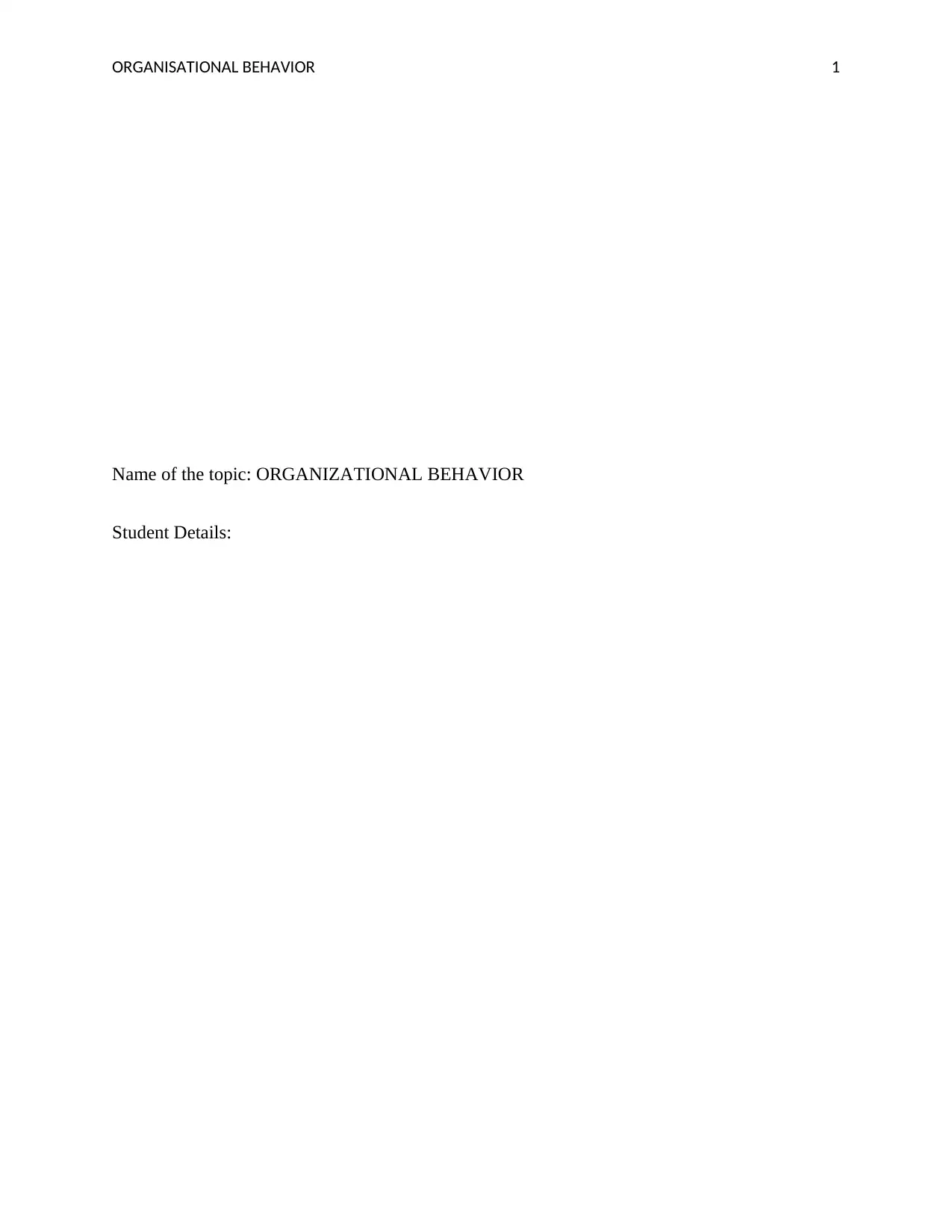
ORGANISATIONAL BEHAVIOR 1
Name of the topic: ORGANIZATIONAL BEHAVIOR
Student Details:
Name of the topic: ORGANIZATIONAL BEHAVIOR
Student Details:
Paraphrase This Document
Need a fresh take? Get an instant paraphrase of this document with our AI Paraphraser
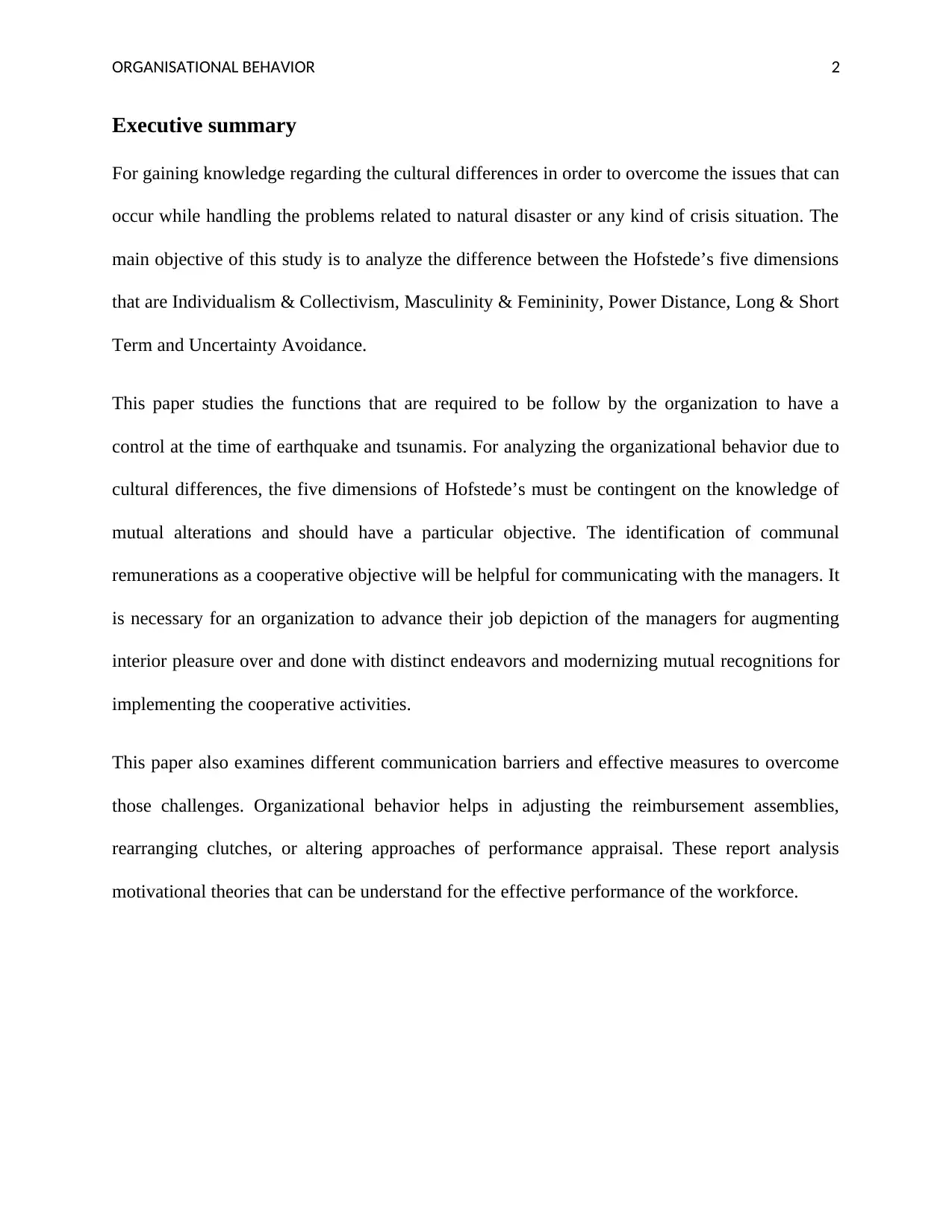
ORGANISATIONAL BEHAVIOR 2
Executive summary
For gaining knowledge regarding the cultural differences in order to overcome the issues that can
occur while handling the problems related to natural disaster or any kind of crisis situation. The
main objective of this study is to analyze the difference between the Hofstede’s five dimensions
that are Individualism & Collectivism, Masculinity & Femininity, Power Distance, Long & Short
Term and Uncertainty Avoidance.
This paper studies the functions that are required to be follow by the organization to have a
control at the time of earthquake and tsunamis. For analyzing the organizational behavior due to
cultural differences, the five dimensions of Hofstede’s must be contingent on the knowledge of
mutual alterations and should have a particular objective. The identification of communal
remunerations as a cooperative objective will be helpful for communicating with the managers. It
is necessary for an organization to advance their job depiction of the managers for augmenting
interior pleasure over and done with distinct endeavors and modernizing mutual recognitions for
implementing the cooperative activities.
This paper also examines different communication barriers and effective measures to overcome
those challenges. Organizational behavior helps in adjusting the reimbursement assemblies,
rearranging clutches, or altering approaches of performance appraisal. These report analysis
motivational theories that can be understand for the effective performance of the workforce.
Executive summary
For gaining knowledge regarding the cultural differences in order to overcome the issues that can
occur while handling the problems related to natural disaster or any kind of crisis situation. The
main objective of this study is to analyze the difference between the Hofstede’s five dimensions
that are Individualism & Collectivism, Masculinity & Femininity, Power Distance, Long & Short
Term and Uncertainty Avoidance.
This paper studies the functions that are required to be follow by the organization to have a
control at the time of earthquake and tsunamis. For analyzing the organizational behavior due to
cultural differences, the five dimensions of Hofstede’s must be contingent on the knowledge of
mutual alterations and should have a particular objective. The identification of communal
remunerations as a cooperative objective will be helpful for communicating with the managers. It
is necessary for an organization to advance their job depiction of the managers for augmenting
interior pleasure over and done with distinct endeavors and modernizing mutual recognitions for
implementing the cooperative activities.
This paper also examines different communication barriers and effective measures to overcome
those challenges. Organizational behavior helps in adjusting the reimbursement assemblies,
rearranging clutches, or altering approaches of performance appraisal. These report analysis
motivational theories that can be understand for the effective performance of the workforce.
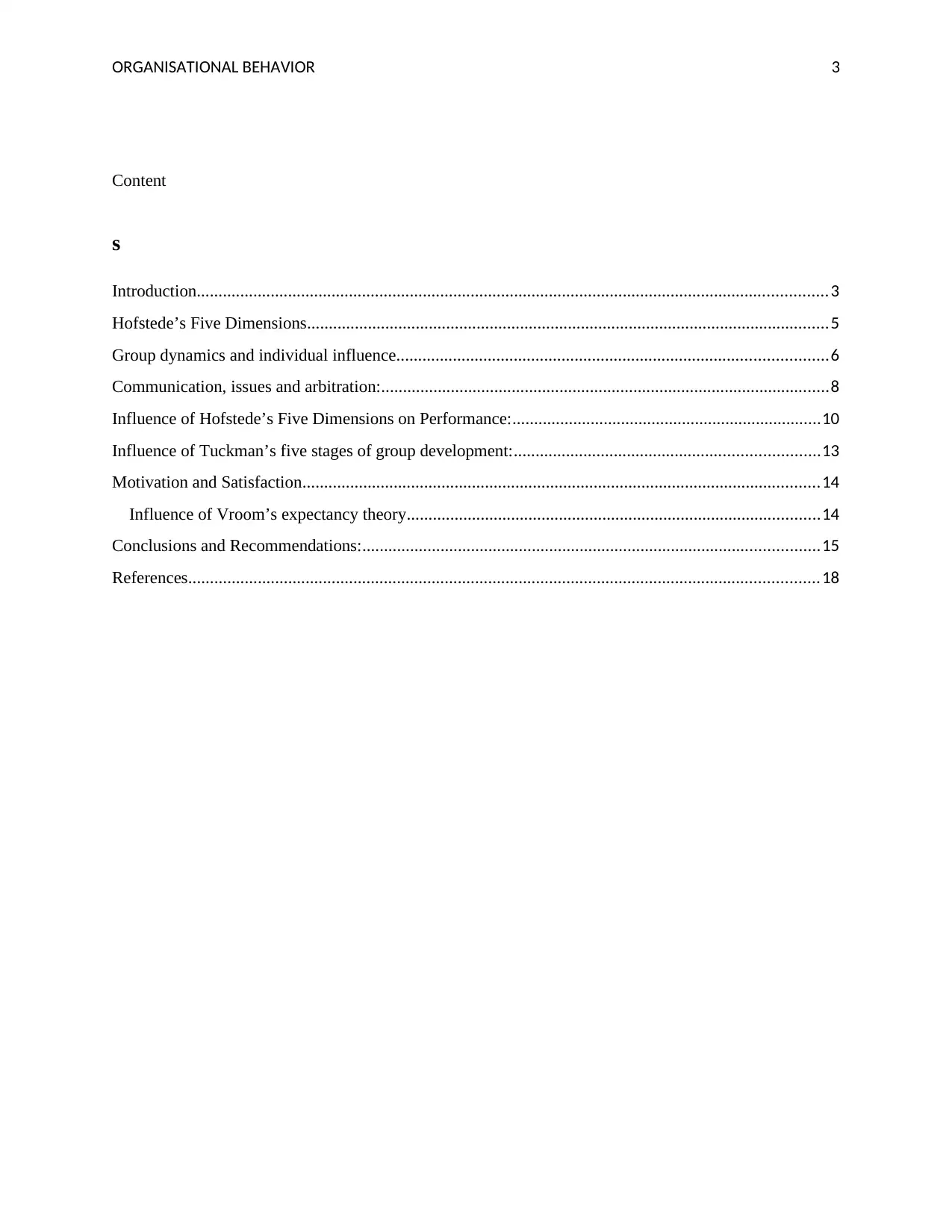
ORGANISATIONAL BEHAVIOR 3
Content
s
Introduction.................................................................................................................................................3
Hofstede’s Five Dimensions........................................................................................................................5
Group dynamics and individual influence...................................................................................................6
Communication, issues and arbitration:.......................................................................................................8
Influence of Hofstede’s Five Dimensions on Performance:.......................................................................10
Influence of Tuckman’s five stages of group development:......................................................................13
Motivation and Satisfaction.......................................................................................................................14
Influence of Vroom’s expectancy theory...............................................................................................14
Conclusions and Recommendations:.........................................................................................................15
References.................................................................................................................................................18
Content
s
Introduction.................................................................................................................................................3
Hofstede’s Five Dimensions........................................................................................................................5
Group dynamics and individual influence...................................................................................................6
Communication, issues and arbitration:.......................................................................................................8
Influence of Hofstede’s Five Dimensions on Performance:.......................................................................10
Influence of Tuckman’s five stages of group development:......................................................................13
Motivation and Satisfaction.......................................................................................................................14
Influence of Vroom’s expectancy theory...............................................................................................14
Conclusions and Recommendations:.........................................................................................................15
References.................................................................................................................................................18
⊘ This is a preview!⊘
Do you want full access?
Subscribe today to unlock all pages.

Trusted by 1+ million students worldwide
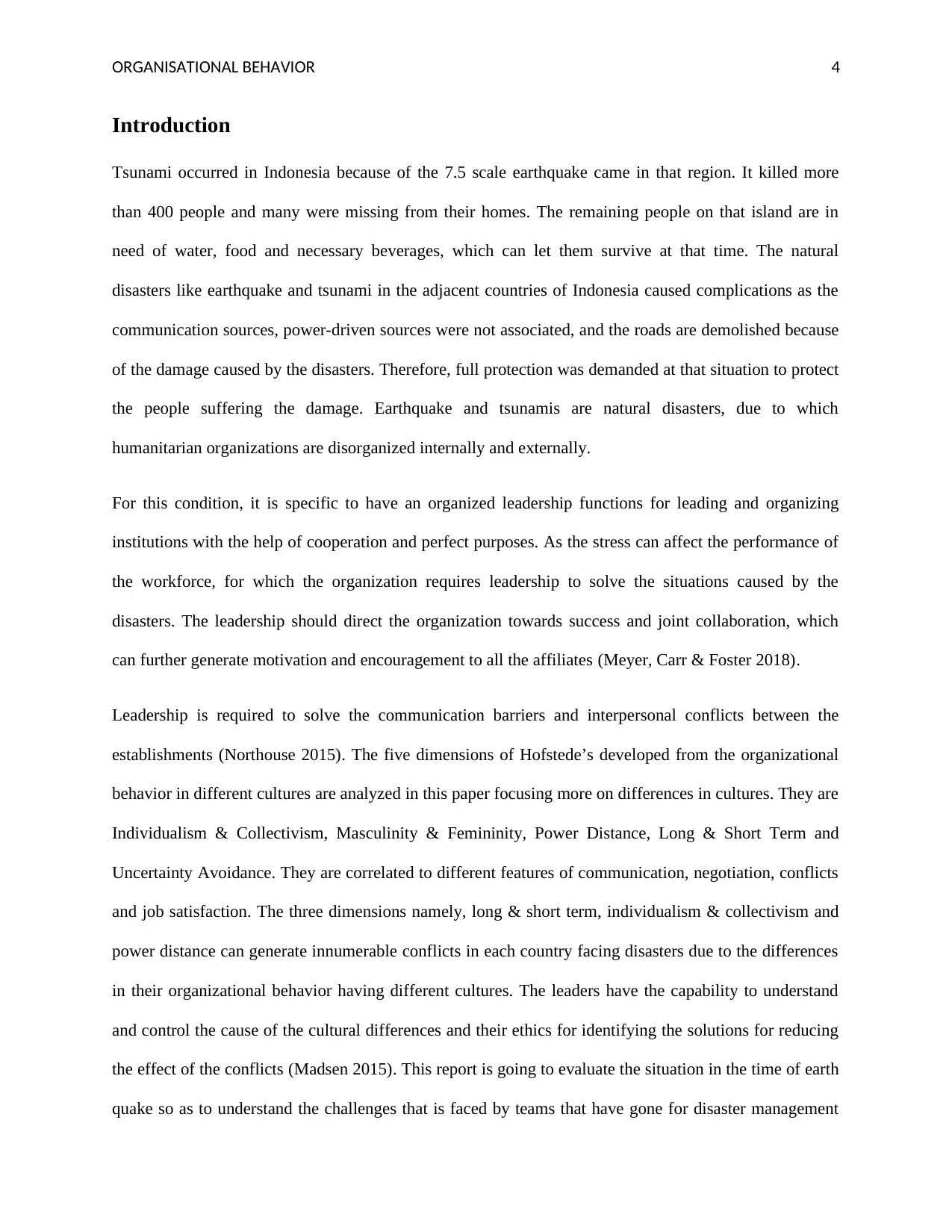
ORGANISATIONAL BEHAVIOR 4
Introduction
Tsunami occurred in Indonesia because of the 7.5 scale earthquake came in that region. It killed more
than 400 people and many were missing from their homes. The remaining people on that island are in
need of water, food and necessary beverages, which can let them survive at that time. The natural
disasters like earthquake and tsunami in the adjacent countries of Indonesia caused complications as the
communication sources, power-driven sources were not associated, and the roads are demolished because
of the damage caused by the disasters. Therefore, full protection was demanded at that situation to protect
the people suffering the damage. Earthquake and tsunamis are natural disasters, due to which
humanitarian organizations are disorganized internally and externally.
For this condition, it is specific to have an organized leadership functions for leading and organizing
institutions with the help of cooperation and perfect purposes. As the stress can affect the performance of
the workforce, for which the organization requires leadership to solve the situations caused by the
disasters. The leadership should direct the organization towards success and joint collaboration, which
can further generate motivation and encouragement to all the affiliates (Meyer, Carr & Foster 2018).
Leadership is required to solve the communication barriers and interpersonal conflicts between the
establishments (Northouse 2015). The five dimensions of Hofstede’s developed from the organizational
behavior in different cultures are analyzed in this paper focusing more on differences in cultures. They are
Individualism & Collectivism, Masculinity & Femininity, Power Distance, Long & Short Term and
Uncertainty Avoidance. They are correlated to different features of communication, negotiation, conflicts
and job satisfaction. The three dimensions namely, long & short term, individualism & collectivism and
power distance can generate innumerable conflicts in each country facing disasters due to the differences
in their organizational behavior having different cultures. The leaders have the capability to understand
and control the cause of the cultural differences and their ethics for identifying the solutions for reducing
the effect of the conflicts (Madsen 2015). This report is going to evaluate the situation in the time of earth
quake so as to understand the challenges that is faced by teams that have gone for disaster management
Introduction
Tsunami occurred in Indonesia because of the 7.5 scale earthquake came in that region. It killed more
than 400 people and many were missing from their homes. The remaining people on that island are in
need of water, food and necessary beverages, which can let them survive at that time. The natural
disasters like earthquake and tsunami in the adjacent countries of Indonesia caused complications as the
communication sources, power-driven sources were not associated, and the roads are demolished because
of the damage caused by the disasters. Therefore, full protection was demanded at that situation to protect
the people suffering the damage. Earthquake and tsunamis are natural disasters, due to which
humanitarian organizations are disorganized internally and externally.
For this condition, it is specific to have an organized leadership functions for leading and organizing
institutions with the help of cooperation and perfect purposes. As the stress can affect the performance of
the workforce, for which the organization requires leadership to solve the situations caused by the
disasters. The leadership should direct the organization towards success and joint collaboration, which
can further generate motivation and encouragement to all the affiliates (Meyer, Carr & Foster 2018).
Leadership is required to solve the communication barriers and interpersonal conflicts between the
establishments (Northouse 2015). The five dimensions of Hofstede’s developed from the organizational
behavior in different cultures are analyzed in this paper focusing more on differences in cultures. They are
Individualism & Collectivism, Masculinity & Femininity, Power Distance, Long & Short Term and
Uncertainty Avoidance. They are correlated to different features of communication, negotiation, conflicts
and job satisfaction. The three dimensions namely, long & short term, individualism & collectivism and
power distance can generate innumerable conflicts in each country facing disasters due to the differences
in their organizational behavior having different cultures. The leaders have the capability to understand
and control the cause of the cultural differences and their ethics for identifying the solutions for reducing
the effect of the conflicts (Madsen 2015). This report is going to evaluate the situation in the time of earth
quake so as to understand the challenges that is faced by teams that have gone for disaster management
Paraphrase This Document
Need a fresh take? Get an instant paraphrase of this document with our AI Paraphraser
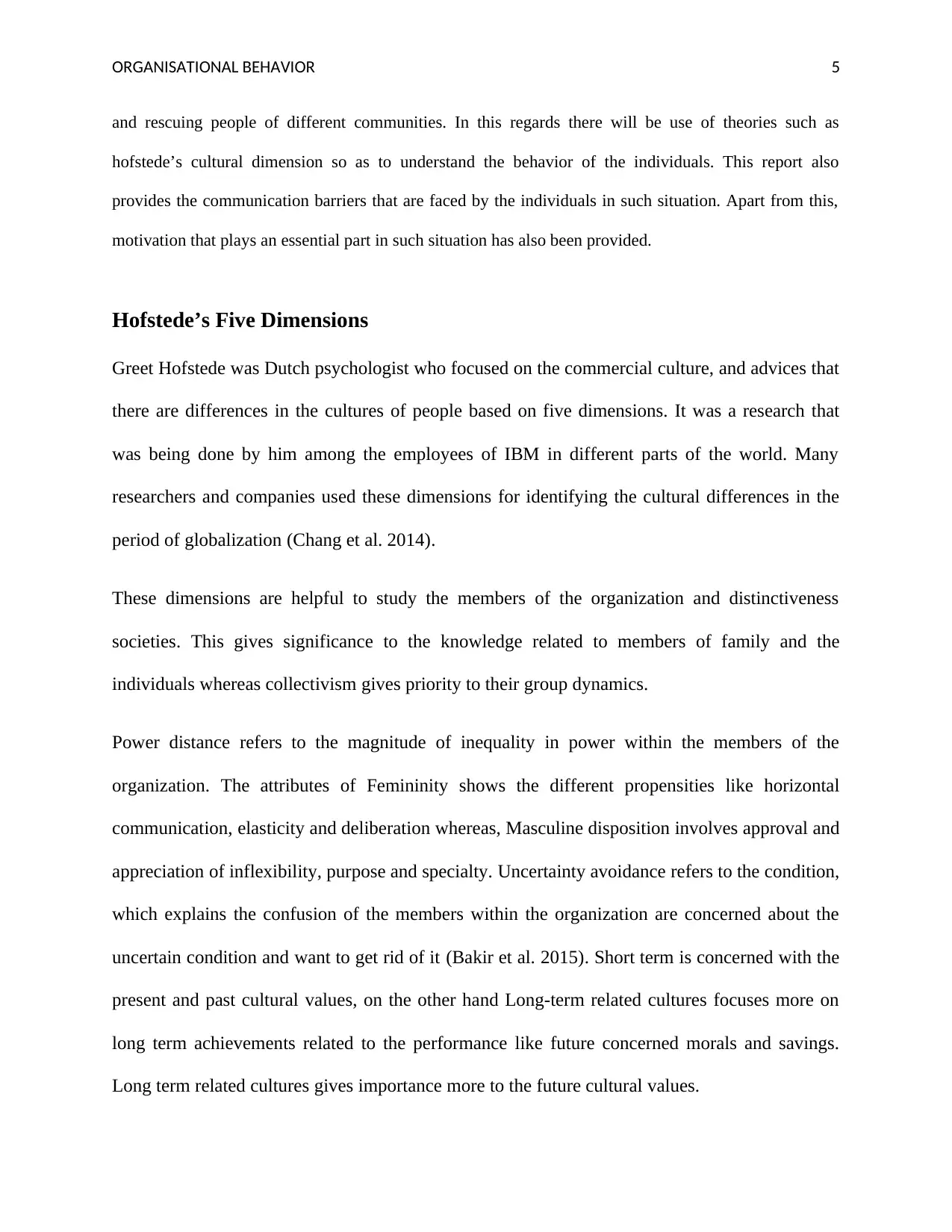
ORGANISATIONAL BEHAVIOR 5
and rescuing people of different communities. In this regards there will be use of theories such as
hofstede’s cultural dimension so as to understand the behavior of the individuals. This report also
provides the communication barriers that are faced by the individuals in such situation. Apart from this,
motivation that plays an essential part in such situation has also been provided.
Hofstede’s Five Dimensions
Greet Hofstede was Dutch psychologist who focused on the commercial culture, and advices that
there are differences in the cultures of people based on five dimensions. It was a research that
was being done by him among the employees of IBM in different parts of the world. Many
researchers and companies used these dimensions for identifying the cultural differences in the
period of globalization (Chang et al. 2014).
These dimensions are helpful to study the members of the organization and distinctiveness
societies. This gives significance to the knowledge related to members of family and the
individuals whereas collectivism gives priority to their group dynamics.
Power distance refers to the magnitude of inequality in power within the members of the
organization. The attributes of Femininity shows the different propensities like horizontal
communication, elasticity and deliberation whereas, Masculine disposition involves approval and
appreciation of inflexibility, purpose and specialty. Uncertainty avoidance refers to the condition,
which explains the confusion of the members within the organization are concerned about the
uncertain condition and want to get rid of it (Bakir et al. 2015). Short term is concerned with the
present and past cultural values, on the other hand Long-term related cultures focuses more on
long term achievements related to the performance like future concerned morals and savings.
Long term related cultures gives importance more to the future cultural values.
and rescuing people of different communities. In this regards there will be use of theories such as
hofstede’s cultural dimension so as to understand the behavior of the individuals. This report also
provides the communication barriers that are faced by the individuals in such situation. Apart from this,
motivation that plays an essential part in such situation has also been provided.
Hofstede’s Five Dimensions
Greet Hofstede was Dutch psychologist who focused on the commercial culture, and advices that
there are differences in the cultures of people based on five dimensions. It was a research that
was being done by him among the employees of IBM in different parts of the world. Many
researchers and companies used these dimensions for identifying the cultural differences in the
period of globalization (Chang et al. 2014).
These dimensions are helpful to study the members of the organization and distinctiveness
societies. This gives significance to the knowledge related to members of family and the
individuals whereas collectivism gives priority to their group dynamics.
Power distance refers to the magnitude of inequality in power within the members of the
organization. The attributes of Femininity shows the different propensities like horizontal
communication, elasticity and deliberation whereas, Masculine disposition involves approval and
appreciation of inflexibility, purpose and specialty. Uncertainty avoidance refers to the condition,
which explains the confusion of the members within the organization are concerned about the
uncertain condition and want to get rid of it (Bakir et al. 2015). Short term is concerned with the
present and past cultural values, on the other hand Long-term related cultures focuses more on
long term achievements related to the performance like future concerned morals and savings.
Long term related cultures gives importance more to the future cultural values.
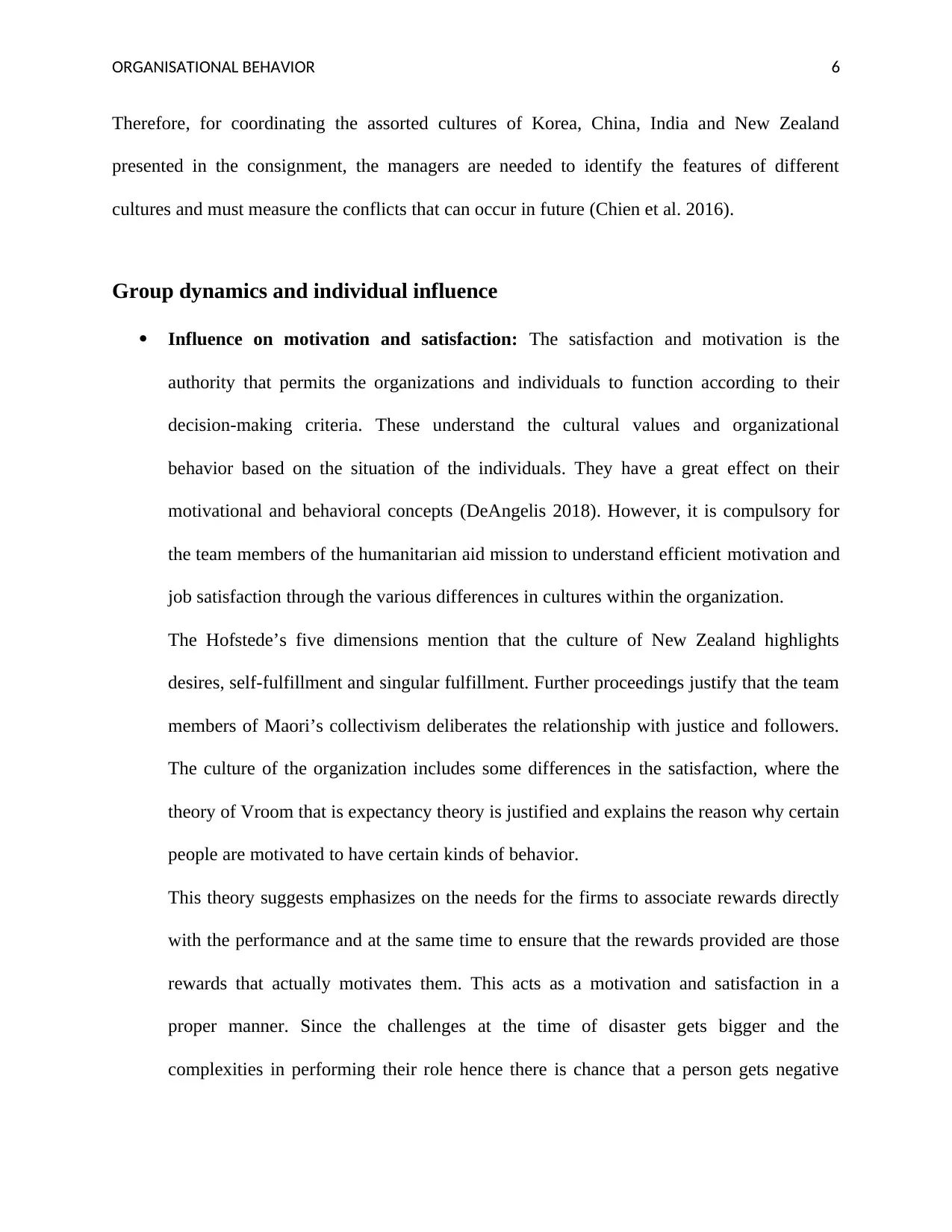
ORGANISATIONAL BEHAVIOR 6
Therefore, for coordinating the assorted cultures of Korea, China, India and New Zealand
presented in the consignment, the managers are needed to identify the features of different
cultures and must measure the conflicts that can occur in future (Chien et al. 2016).
Group dynamics and individual influence
Influence on motivation and satisfaction: The satisfaction and motivation is the
authority that permits the organizations and individuals to function according to their
decision-making criteria. These understand the cultural values and organizational
behavior based on the situation of the individuals. They have a great effect on their
motivational and behavioral concepts (DeAngelis 2018). However, it is compulsory for
the team members of the humanitarian aid mission to understand efficient motivation and
job satisfaction through the various differences in cultures within the organization.
The Hofstede’s five dimensions mention that the culture of New Zealand highlights
desires, self-fulfillment and singular fulfillment. Further proceedings justify that the team
members of Maori’s collectivism deliberates the relationship with justice and followers.
The culture of the organization includes some differences in the satisfaction, where the
theory of Vroom that is expectancy theory is justified and explains the reason why certain
people are motivated to have certain kinds of behavior.
This theory suggests emphasizes on the needs for the firms to associate rewards directly
with the performance and at the same time to ensure that the rewards provided are those
rewards that actually motivates them. This acts as a motivation and satisfaction in a
proper manner. Since the challenges at the time of disaster gets bigger and the
complexities in performing their role hence there is chance that a person gets negative
Therefore, for coordinating the assorted cultures of Korea, China, India and New Zealand
presented in the consignment, the managers are needed to identify the features of different
cultures and must measure the conflicts that can occur in future (Chien et al. 2016).
Group dynamics and individual influence
Influence on motivation and satisfaction: The satisfaction and motivation is the
authority that permits the organizations and individuals to function according to their
decision-making criteria. These understand the cultural values and organizational
behavior based on the situation of the individuals. They have a great effect on their
motivational and behavioral concepts (DeAngelis 2018). However, it is compulsory for
the team members of the humanitarian aid mission to understand efficient motivation and
job satisfaction through the various differences in cultures within the organization.
The Hofstede’s five dimensions mention that the culture of New Zealand highlights
desires, self-fulfillment and singular fulfillment. Further proceedings justify that the team
members of Maori’s collectivism deliberates the relationship with justice and followers.
The culture of the organization includes some differences in the satisfaction, where the
theory of Vroom that is expectancy theory is justified and explains the reason why certain
people are motivated to have certain kinds of behavior.
This theory suggests emphasizes on the needs for the firms to associate rewards directly
with the performance and at the same time to ensure that the rewards provided are those
rewards that actually motivates them. This acts as a motivation and satisfaction in a
proper manner. Since the challenges at the time of disaster gets bigger and the
complexities in performing their role hence there is chance that a person gets negative
⊘ This is a preview!⊘
Do you want full access?
Subscribe today to unlock all pages.

Trusted by 1+ million students worldwide
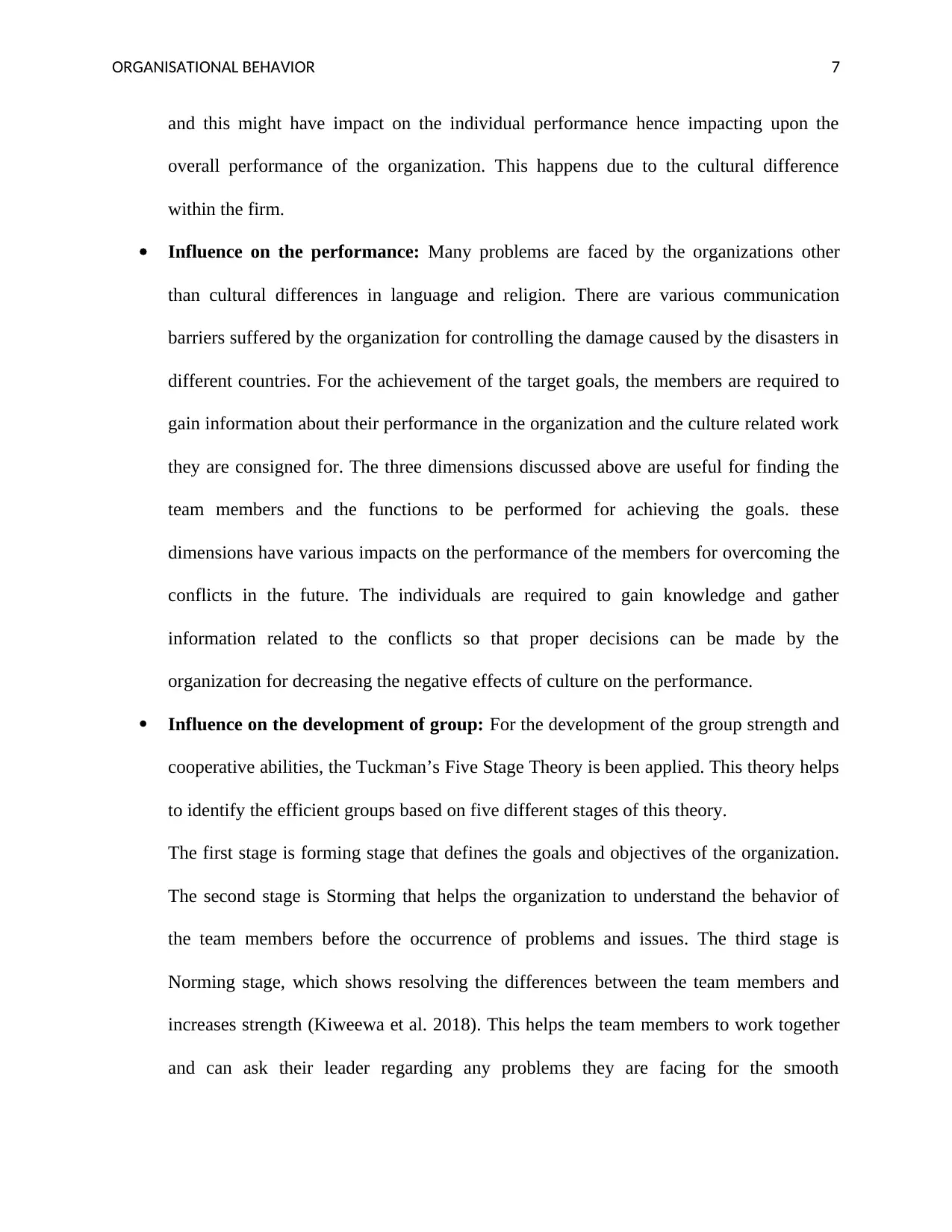
ORGANISATIONAL BEHAVIOR 7
and this might have impact on the individual performance hence impacting upon the
overall performance of the organization. This happens due to the cultural difference
within the firm.
Influence on the performance: Many problems are faced by the organizations other
than cultural differences in language and religion. There are various communication
barriers suffered by the organization for controlling the damage caused by the disasters in
different countries. For the achievement of the target goals, the members are required to
gain information about their performance in the organization and the culture related work
they are consigned for. The three dimensions discussed above are useful for finding the
team members and the functions to be performed for achieving the goals. these
dimensions have various impacts on the performance of the members for overcoming the
conflicts in the future. The individuals are required to gain knowledge and gather
information related to the conflicts so that proper decisions can be made by the
organization for decreasing the negative effects of culture on the performance.
Influence on the development of group: For the development of the group strength and
cooperative abilities, the Tuckman’s Five Stage Theory is been applied. This theory helps
to identify the efficient groups based on five different stages of this theory.
The first stage is forming stage that defines the goals and objectives of the organization.
The second stage is Storming that helps the organization to understand the behavior of
the team members before the occurrence of problems and issues. The third stage is
Norming stage, which shows resolving the differences between the team members and
increases strength (Kiweewa et al. 2018). This helps the team members to work together
and can ask their leader regarding any problems they are facing for the smooth
and this might have impact on the individual performance hence impacting upon the
overall performance of the organization. This happens due to the cultural difference
within the firm.
Influence on the performance: Many problems are faced by the organizations other
than cultural differences in language and religion. There are various communication
barriers suffered by the organization for controlling the damage caused by the disasters in
different countries. For the achievement of the target goals, the members are required to
gain information about their performance in the organization and the culture related work
they are consigned for. The three dimensions discussed above are useful for finding the
team members and the functions to be performed for achieving the goals. these
dimensions have various impacts on the performance of the members for overcoming the
conflicts in the future. The individuals are required to gain knowledge and gather
information related to the conflicts so that proper decisions can be made by the
organization for decreasing the negative effects of culture on the performance.
Influence on the development of group: For the development of the group strength and
cooperative abilities, the Tuckman’s Five Stage Theory is been applied. This theory helps
to identify the efficient groups based on five different stages of this theory.
The first stage is forming stage that defines the goals and objectives of the organization.
The second stage is Storming that helps the organization to understand the behavior of
the team members before the occurrence of problems and issues. The third stage is
Norming stage, which shows resolving the differences between the team members and
increases strength (Kiweewa et al. 2018). This helps the team members to work together
and can ask their leader regarding any problems they are facing for the smooth
Paraphrase This Document
Need a fresh take? Get an instant paraphrase of this document with our AI Paraphraser
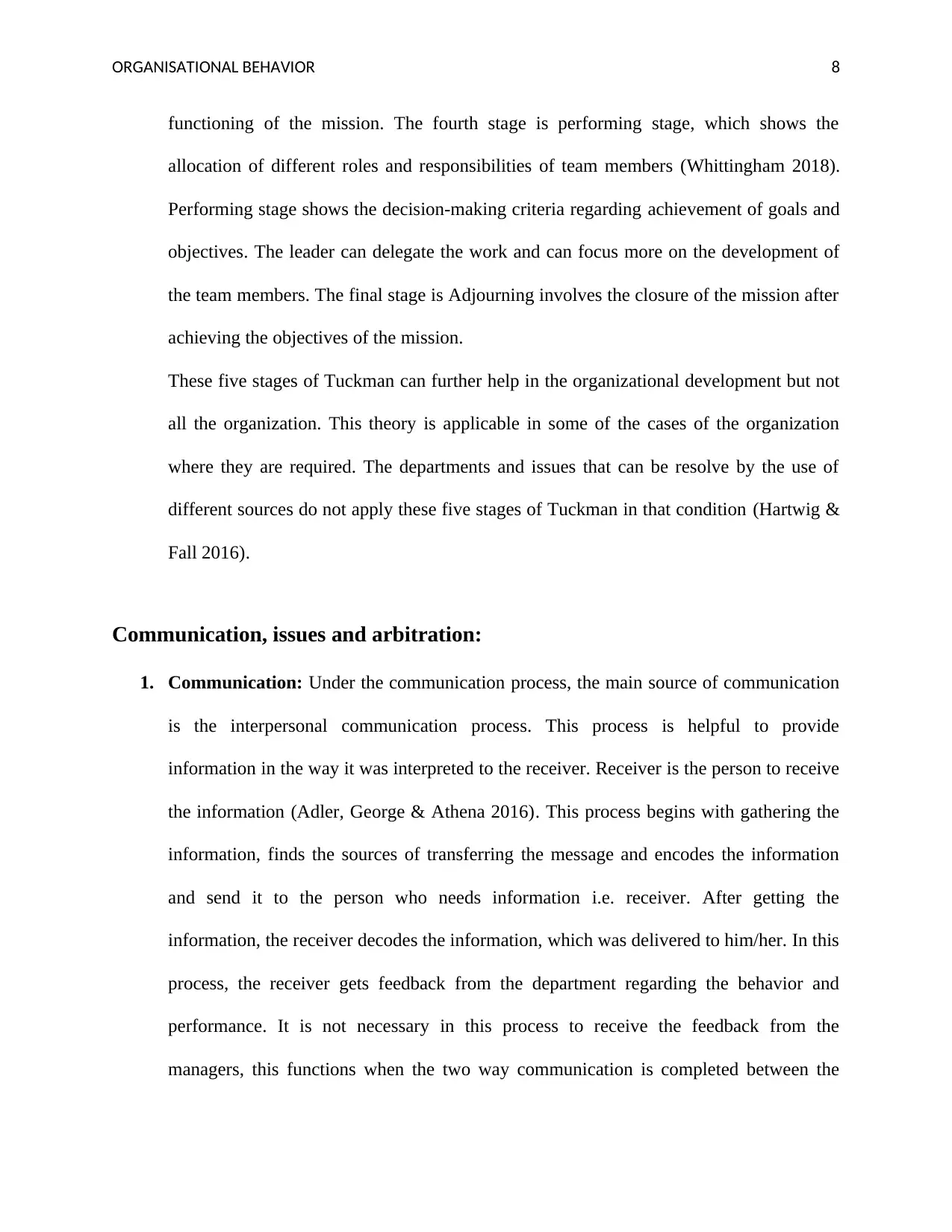
ORGANISATIONAL BEHAVIOR 8
functioning of the mission. The fourth stage is performing stage, which shows the
allocation of different roles and responsibilities of team members (Whittingham 2018).
Performing stage shows the decision-making criteria regarding achievement of goals and
objectives. The leader can delegate the work and can focus more on the development of
the team members. The final stage is Adjourning involves the closure of the mission after
achieving the objectives of the mission.
These five stages of Tuckman can further help in the organizational development but not
all the organization. This theory is applicable in some of the cases of the organization
where they are required. The departments and issues that can be resolve by the use of
different sources do not apply these five stages of Tuckman in that condition (Hartwig &
Fall 2016).
Communication, issues and arbitration:
1. Communication: Under the communication process, the main source of communication
is the interpersonal communication process. This process is helpful to provide
information in the way it was interpreted to the receiver. Receiver is the person to receive
the information (Adler, George & Athena 2016). This process begins with gathering the
information, finds the sources of transferring the message and encodes the information
and send it to the person who needs information i.e. receiver. After getting the
information, the receiver decodes the information, which was delivered to him/her. In this
process, the receiver gets feedback from the department regarding the behavior and
performance. It is not necessary in this process to receive the feedback from the
managers, this functions when the two way communication is completed between the
functioning of the mission. The fourth stage is performing stage, which shows the
allocation of different roles and responsibilities of team members (Whittingham 2018).
Performing stage shows the decision-making criteria regarding achievement of goals and
objectives. The leader can delegate the work and can focus more on the development of
the team members. The final stage is Adjourning involves the closure of the mission after
achieving the objectives of the mission.
These five stages of Tuckman can further help in the organizational development but not
all the organization. This theory is applicable in some of the cases of the organization
where they are required. The departments and issues that can be resolve by the use of
different sources do not apply these five stages of Tuckman in that condition (Hartwig &
Fall 2016).
Communication, issues and arbitration:
1. Communication: Under the communication process, the main source of communication
is the interpersonal communication process. This process is helpful to provide
information in the way it was interpreted to the receiver. Receiver is the person to receive
the information (Adler, George & Athena 2016). This process begins with gathering the
information, finds the sources of transferring the message and encodes the information
and send it to the person who needs information i.e. receiver. After getting the
information, the receiver decodes the information, which was delivered to him/her. In this
process, the receiver gets feedback from the department regarding the behavior and
performance. It is not necessary in this process to receive the feedback from the
managers, this functions when the two way communication is completed between the
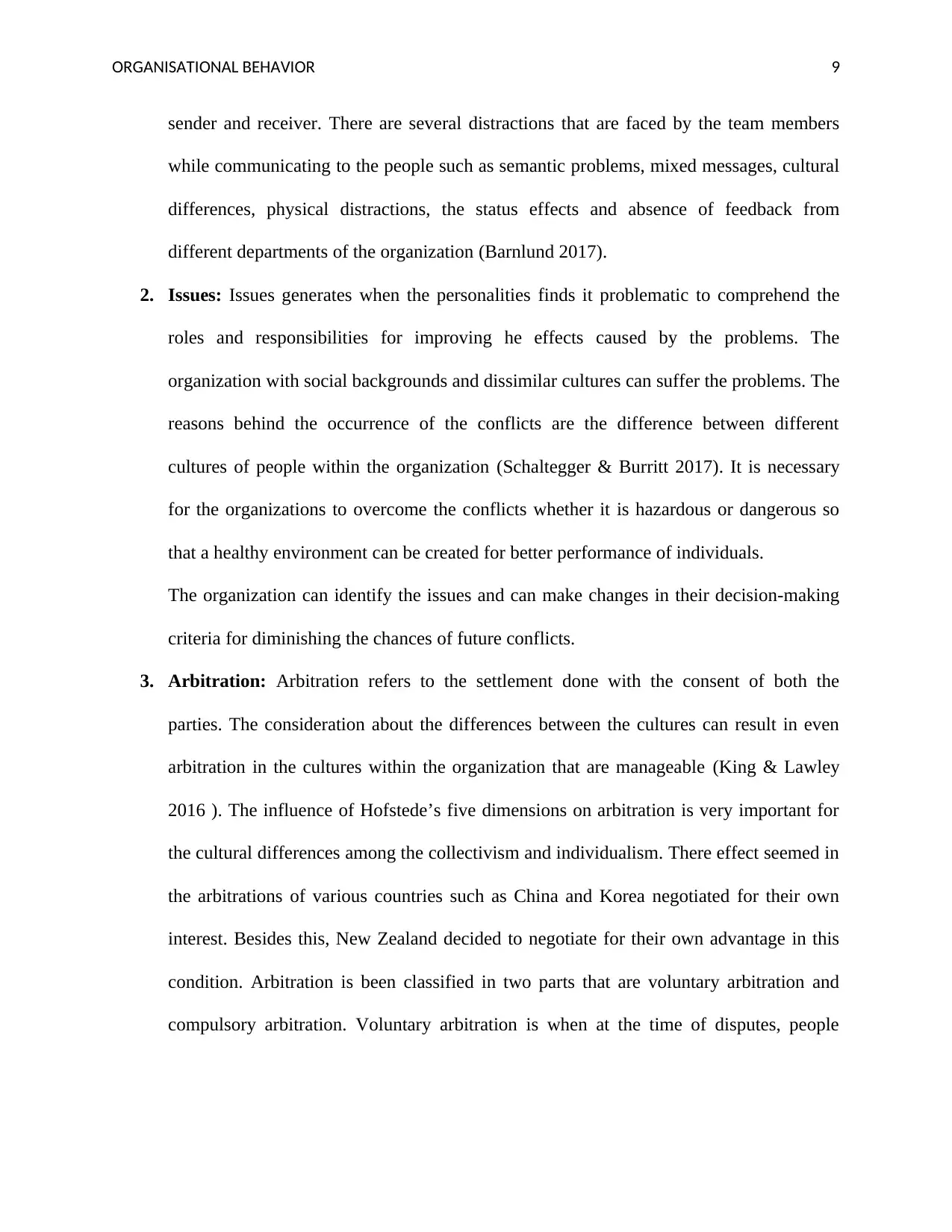
ORGANISATIONAL BEHAVIOR 9
sender and receiver. There are several distractions that are faced by the team members
while communicating to the people such as semantic problems, mixed messages, cultural
differences, physical distractions, the status effects and absence of feedback from
different departments of the organization (Barnlund 2017).
2. Issues: Issues generates when the personalities finds it problematic to comprehend the
roles and responsibilities for improving he effects caused by the problems. The
organization with social backgrounds and dissimilar cultures can suffer the problems. The
reasons behind the occurrence of the conflicts are the difference between different
cultures of people within the organization (Schaltegger & Burritt 2017). It is necessary
for the organizations to overcome the conflicts whether it is hazardous or dangerous so
that a healthy environment can be created for better performance of individuals.
The organization can identify the issues and can make changes in their decision-making
criteria for diminishing the chances of future conflicts.
3. Arbitration: Arbitration refers to the settlement done with the consent of both the
parties. The consideration about the differences between the cultures can result in even
arbitration in the cultures within the organization that are manageable (King & Lawley
2016 ). The influence of Hofstede’s five dimensions on arbitration is very important for
the cultural differences among the collectivism and individualism. There effect seemed in
the arbitrations of various countries such as China and Korea negotiated for their own
interest. Besides this, New Zealand decided to negotiate for their own advantage in this
condition. Arbitration is been classified in two parts that are voluntary arbitration and
compulsory arbitration. Voluntary arbitration is when at the time of disputes, people
sender and receiver. There are several distractions that are faced by the team members
while communicating to the people such as semantic problems, mixed messages, cultural
differences, physical distractions, the status effects and absence of feedback from
different departments of the organization (Barnlund 2017).
2. Issues: Issues generates when the personalities finds it problematic to comprehend the
roles and responsibilities for improving he effects caused by the problems. The
organization with social backgrounds and dissimilar cultures can suffer the problems. The
reasons behind the occurrence of the conflicts are the difference between different
cultures of people within the organization (Schaltegger & Burritt 2017). It is necessary
for the organizations to overcome the conflicts whether it is hazardous or dangerous so
that a healthy environment can be created for better performance of individuals.
The organization can identify the issues and can make changes in their decision-making
criteria for diminishing the chances of future conflicts.
3. Arbitration: Arbitration refers to the settlement done with the consent of both the
parties. The consideration about the differences between the cultures can result in even
arbitration in the cultures within the organization that are manageable (King & Lawley
2016 ). The influence of Hofstede’s five dimensions on arbitration is very important for
the cultural differences among the collectivism and individualism. There effect seemed in
the arbitrations of various countries such as China and Korea negotiated for their own
interest. Besides this, New Zealand decided to negotiate for their own advantage in this
condition. Arbitration is been classified in two parts that are voluntary arbitration and
compulsory arbitration. Voluntary arbitration is when at the time of disputes, people
⊘ This is a preview!⊘
Do you want full access?
Subscribe today to unlock all pages.

Trusted by 1+ million students worldwide
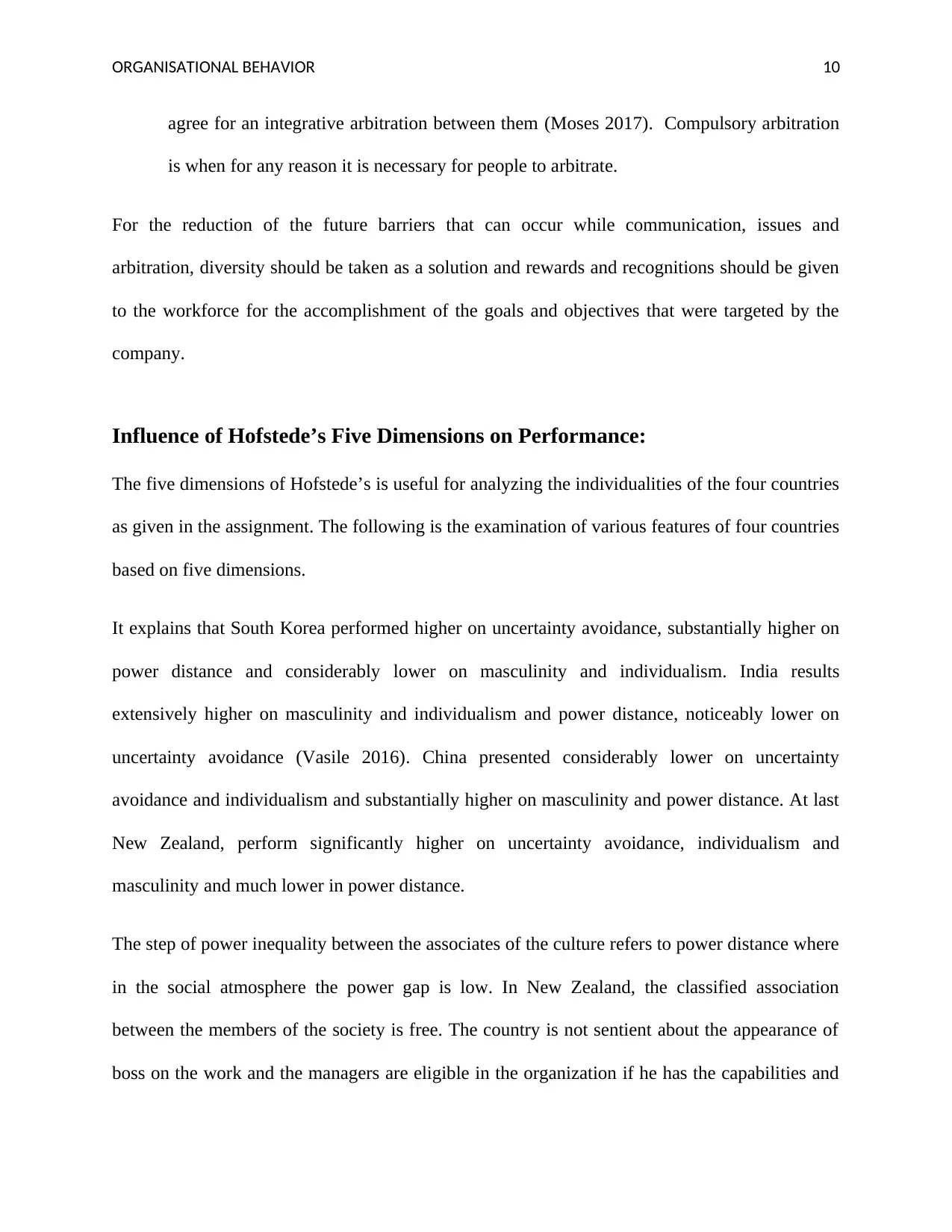
ORGANISATIONAL BEHAVIOR 10
agree for an integrative arbitration between them (Moses 2017). Compulsory arbitration
is when for any reason it is necessary for people to arbitrate.
For the reduction of the future barriers that can occur while communication, issues and
arbitration, diversity should be taken as a solution and rewards and recognitions should be given
to the workforce for the accomplishment of the goals and objectives that were targeted by the
company.
Influence of Hofstede’s Five Dimensions on Performance:
The five dimensions of Hofstede’s is useful for analyzing the individualities of the four countries
as given in the assignment. The following is the examination of various features of four countries
based on five dimensions.
It explains that South Korea performed higher on uncertainty avoidance, substantially higher on
power distance and considerably lower on masculinity and individualism. India results
extensively higher on masculinity and individualism and power distance, noticeably lower on
uncertainty avoidance (Vasile 2016). China presented considerably lower on uncertainty
avoidance and individualism and substantially higher on masculinity and power distance. At last
New Zealand, perform significantly higher on uncertainty avoidance, individualism and
masculinity and much lower in power distance.
The step of power inequality between the associates of the culture refers to power distance where
in the social atmosphere the power gap is low. In New Zealand, the classified association
between the members of the society is free. The country is not sentient about the appearance of
boss on the work and the managers are eligible in the organization if he has the capabilities and
agree for an integrative arbitration between them (Moses 2017). Compulsory arbitration
is when for any reason it is necessary for people to arbitrate.
For the reduction of the future barriers that can occur while communication, issues and
arbitration, diversity should be taken as a solution and rewards and recognitions should be given
to the workforce for the accomplishment of the goals and objectives that were targeted by the
company.
Influence of Hofstede’s Five Dimensions on Performance:
The five dimensions of Hofstede’s is useful for analyzing the individualities of the four countries
as given in the assignment. The following is the examination of various features of four countries
based on five dimensions.
It explains that South Korea performed higher on uncertainty avoidance, substantially higher on
power distance and considerably lower on masculinity and individualism. India results
extensively higher on masculinity and individualism and power distance, noticeably lower on
uncertainty avoidance (Vasile 2016). China presented considerably lower on uncertainty
avoidance and individualism and substantially higher on masculinity and power distance. At last
New Zealand, perform significantly higher on uncertainty avoidance, individualism and
masculinity and much lower in power distance.
The step of power inequality between the associates of the culture refers to power distance where
in the social atmosphere the power gap is low. In New Zealand, the classified association
between the members of the society is free. The country is not sentient about the appearance of
boss on the work and the managers are eligible in the organization if he has the capabilities and
Paraphrase This Document
Need a fresh take? Get an instant paraphrase of this document with our AI Paraphraser
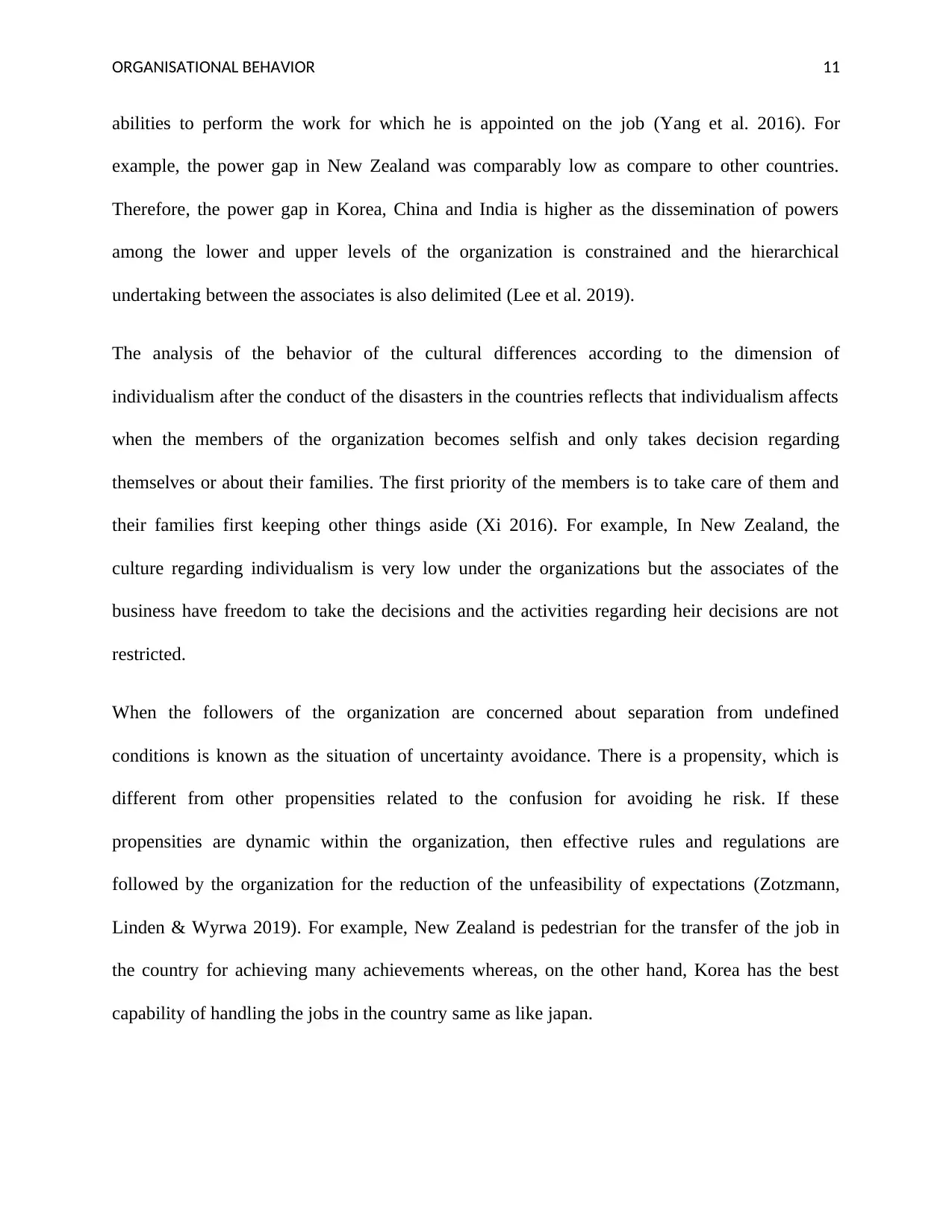
ORGANISATIONAL BEHAVIOR 11
abilities to perform the work for which he is appointed on the job (Yang et al. 2016). For
example, the power gap in New Zealand was comparably low as compare to other countries.
Therefore, the power gap in Korea, China and India is higher as the dissemination of powers
among the lower and upper levels of the organization is constrained and the hierarchical
undertaking between the associates is also delimited (Lee et al. 2019).
The analysis of the behavior of the cultural differences according to the dimension of
individualism after the conduct of the disasters in the countries reflects that individualism affects
when the members of the organization becomes selfish and only takes decision regarding
themselves or about their families. The first priority of the members is to take care of them and
their families first keeping other things aside (Xi 2016). For example, In New Zealand, the
culture regarding individualism is very low under the organizations but the associates of the
business have freedom to take the decisions and the activities regarding heir decisions are not
restricted.
When the followers of the organization are concerned about separation from undefined
conditions is known as the situation of uncertainty avoidance. There is a propensity, which is
different from other propensities related to the confusion for avoiding he risk. If these
propensities are dynamic within the organization, then effective rules and regulations are
followed by the organization for the reduction of the unfeasibility of expectations (Zotzmann,
Linden & Wyrwa 2019). For example, New Zealand is pedestrian for the transfer of the job in
the country for achieving many achievements whereas, on the other hand, Korea has the best
capability of handling the jobs in the country same as like japan.
abilities to perform the work for which he is appointed on the job (Yang et al. 2016). For
example, the power gap in New Zealand was comparably low as compare to other countries.
Therefore, the power gap in Korea, China and India is higher as the dissemination of powers
among the lower and upper levels of the organization is constrained and the hierarchical
undertaking between the associates is also delimited (Lee et al. 2019).
The analysis of the behavior of the cultural differences according to the dimension of
individualism after the conduct of the disasters in the countries reflects that individualism affects
when the members of the organization becomes selfish and only takes decision regarding
themselves or about their families. The first priority of the members is to take care of them and
their families first keeping other things aside (Xi 2016). For example, In New Zealand, the
culture regarding individualism is very low under the organizations but the associates of the
business have freedom to take the decisions and the activities regarding heir decisions are not
restricted.
When the followers of the organization are concerned about separation from undefined
conditions is known as the situation of uncertainty avoidance. There is a propensity, which is
different from other propensities related to the confusion for avoiding he risk. If these
propensities are dynamic within the organization, then effective rules and regulations are
followed by the organization for the reduction of the unfeasibility of expectations (Zotzmann,
Linden & Wyrwa 2019). For example, New Zealand is pedestrian for the transfer of the job in
the country for achieving many achievements whereas, on the other hand, Korea has the best
capability of handling the jobs in the country same as like japan.
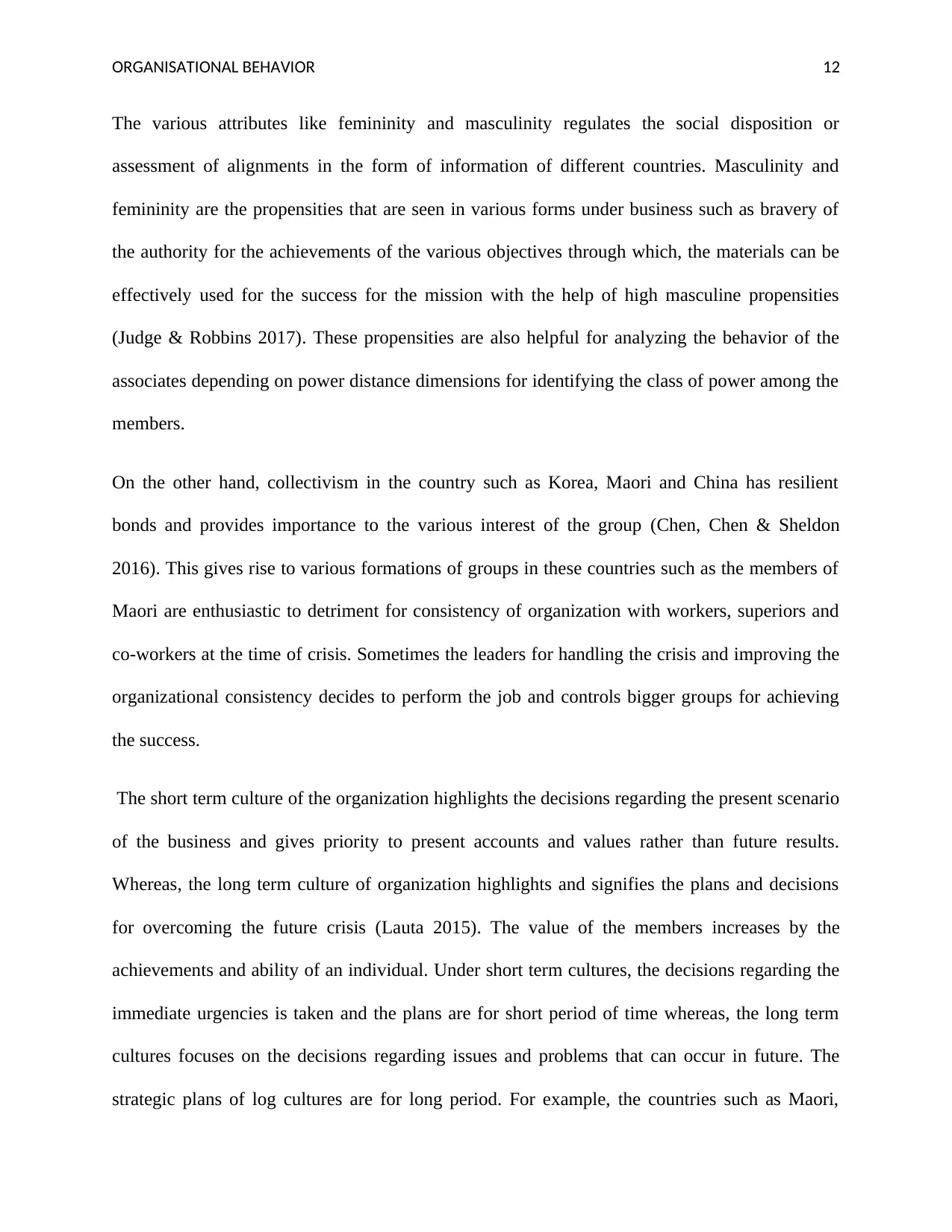
ORGANISATIONAL BEHAVIOR 12
The various attributes like femininity and masculinity regulates the social disposition or
assessment of alignments in the form of information of different countries. Masculinity and
femininity are the propensities that are seen in various forms under business such as bravery of
the authority for the achievements of the various objectives through which, the materials can be
effectively used for the success for the mission with the help of high masculine propensities
(Judge & Robbins 2017). These propensities are also helpful for analyzing the behavior of the
associates depending on power distance dimensions for identifying the class of power among the
members.
On the other hand, collectivism in the country such as Korea, Maori and China has resilient
bonds and provides importance to the various interest of the group (Chen, Chen & Sheldon
2016). This gives rise to various formations of groups in these countries such as the members of
Maori are enthusiastic to detriment for consistency of organization with workers, superiors and
co-workers at the time of crisis. Sometimes the leaders for handling the crisis and improving the
organizational consistency decides to perform the job and controls bigger groups for achieving
the success.
The short term culture of the organization highlights the decisions regarding the present scenario
of the business and gives priority to present accounts and values rather than future results.
Whereas, the long term culture of organization highlights and signifies the plans and decisions
for overcoming the future crisis (Lauta 2015). The value of the members increases by the
achievements and ability of an individual. Under short term cultures, the decisions regarding the
immediate urgencies is taken and the plans are for short period of time whereas, the long term
cultures focuses on the decisions regarding issues and problems that can occur in future. The
strategic plans of log cultures are for long period. For example, the countries such as Maori,
The various attributes like femininity and masculinity regulates the social disposition or
assessment of alignments in the form of information of different countries. Masculinity and
femininity are the propensities that are seen in various forms under business such as bravery of
the authority for the achievements of the various objectives through which, the materials can be
effectively used for the success for the mission with the help of high masculine propensities
(Judge & Robbins 2017). These propensities are also helpful for analyzing the behavior of the
associates depending on power distance dimensions for identifying the class of power among the
members.
On the other hand, collectivism in the country such as Korea, Maori and China has resilient
bonds and provides importance to the various interest of the group (Chen, Chen & Sheldon
2016). This gives rise to various formations of groups in these countries such as the members of
Maori are enthusiastic to detriment for consistency of organization with workers, superiors and
co-workers at the time of crisis. Sometimes the leaders for handling the crisis and improving the
organizational consistency decides to perform the job and controls bigger groups for achieving
the success.
The short term culture of the organization highlights the decisions regarding the present scenario
of the business and gives priority to present accounts and values rather than future results.
Whereas, the long term culture of organization highlights and signifies the plans and decisions
for overcoming the future crisis (Lauta 2015). The value of the members increases by the
achievements and ability of an individual. Under short term cultures, the decisions regarding the
immediate urgencies is taken and the plans are for short period of time whereas, the long term
cultures focuses on the decisions regarding issues and problems that can occur in future. The
strategic plans of log cultures are for long period. For example, the countries such as Maori,
⊘ This is a preview!⊘
Do you want full access?
Subscribe today to unlock all pages.

Trusted by 1+ million students worldwide
1 out of 20
Related Documents
Your All-in-One AI-Powered Toolkit for Academic Success.
+13062052269
info@desklib.com
Available 24*7 on WhatsApp / Email
![[object Object]](/_next/static/media/star-bottom.7253800d.svg)
Unlock your academic potential
Copyright © 2020–2025 A2Z Services. All Rights Reserved. Developed and managed by ZUCOL.





